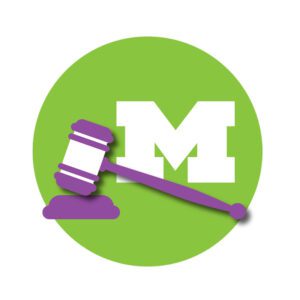After Affirmative Action: At the end of June, the U.S. Supreme Court struck down affirmative action programs at Harvard University and the University of North Carolina, ruling that they violated the 14th Amendment’s Equal Protection Clause. That effectively overturned a landmark case from Ann Arbor twenty years ago—but it will change the U-M much less than Harvard and UNC.
 Black students made up just 4 percent of the U-M student body in 1968, a century after U-M first admitted them. After a 1970 strike by the Black Action Movement, officials agreed to a target of 10 percent. Black undergrads nearly doubled, thanks to a numerically based admissions system that awarded bonus points to Black, Hispanic, and Native American applicants.
Black students made up just 4 percent of the U-M student body in 1968, a century after U-M first admitted them. After a 1970 strike by the Black Action Movement, officials agreed to a target of 10 percent. Black undergrads nearly doubled, thanks to a numerically based admissions system that awarded bonus points to Black, Hispanic, and Native American applicants.
In 2003, the Supreme Court ruled on two lawsuits that challenged the U-M’s affirmative action programs. In Gratz v. Bollinger, it concluded that the points made race so central that the undergrad process violated the Equal Protection Clause of the Fourteenth Amendment. In Grutter v. Bollinger, however, it upheld the law school’s “holistic” affirmative action admissions program.
Undergrad admissions were revised to eliminate the points, but just three years later, Michigan voters amended the state constitution to ban affirmative action in education and government. Convinced that diversity benefits all students, the U-M developed workarounds to attempt to maintain a diverse student body. Now it wants to share that expertise with other colleges.
“We’ve found a few things along the way that have worked and resonated,” says Rick Fitzgerald, the university’s associate VP of public affairs. He notes the “Go Blue Guarantee,” which guarantees four years of undergraduate tuition to in-state students from families whose income and assets are less than $75,000; Wolverine Pathways, which provides “free college preparatory enrichment and guidance for 7th- through 12th-grade students in Detroit, Southfield, Ypsilanti and Grand Rapids,” according to its website; the Kessler Scholars Program, which supports first-generation college students at the U-M; and the American Talent Initiative to “attract, enroll, and graduate” more lower-income students nationwide. And “if you look at the number of Pell Grant–eligible students over time, we’ve made some strong gains,” says Fitzgerald.
Despite that, he says, “we readily admit that socioeconomic factors are not an adequate proxy for race, to achieve racial diversity.” Hispanic students now account for 8 percent of the undergrad enrollment, up from 5 percent in 2006, but there are fewer Native Americans—the university counted just forty at last report. And Black undergrad enrollment peaked at 7.03 percent in 2006. It’s currently 4.47 percent—only slightly more than it was before affirmative action.


Do you actually believe what you publish ?!